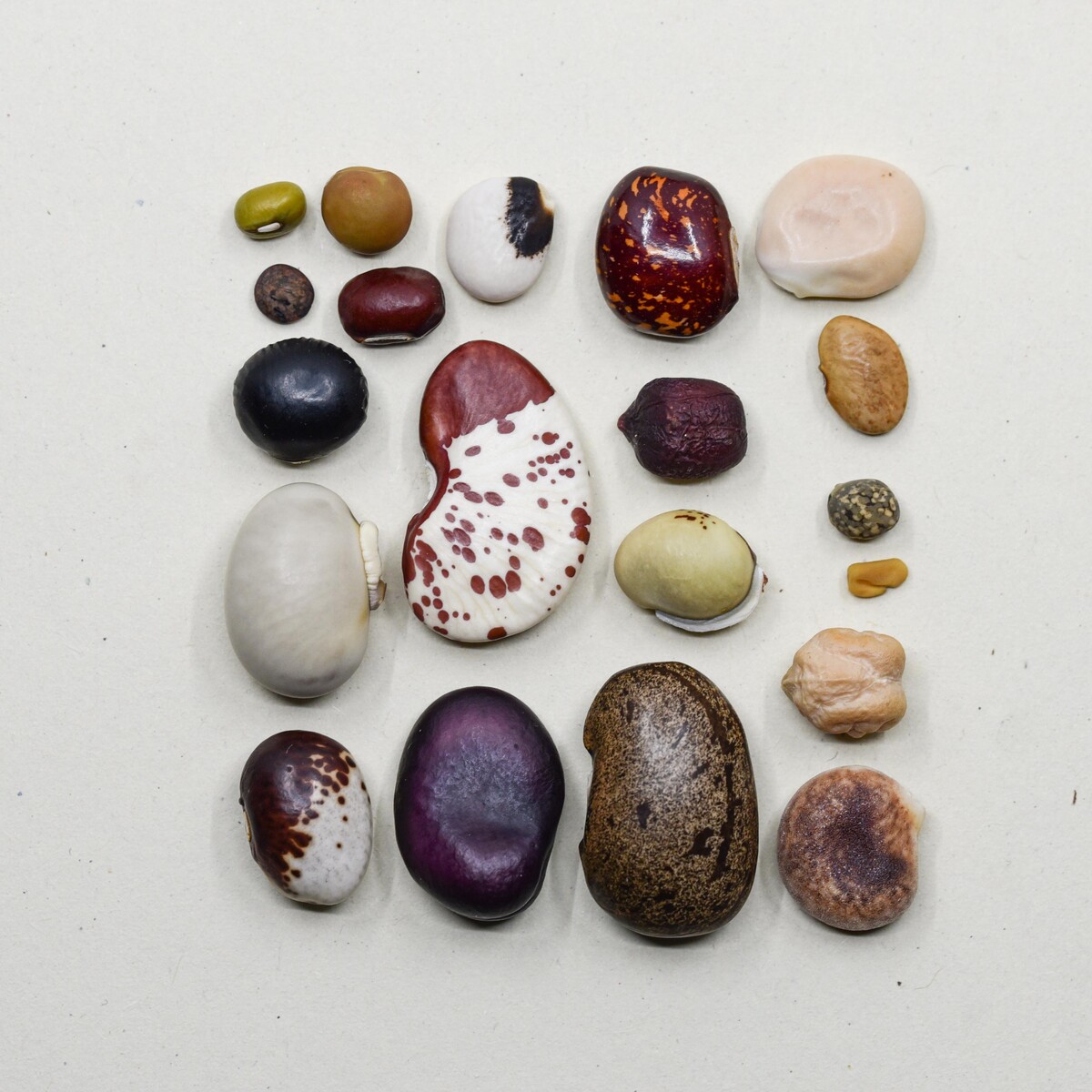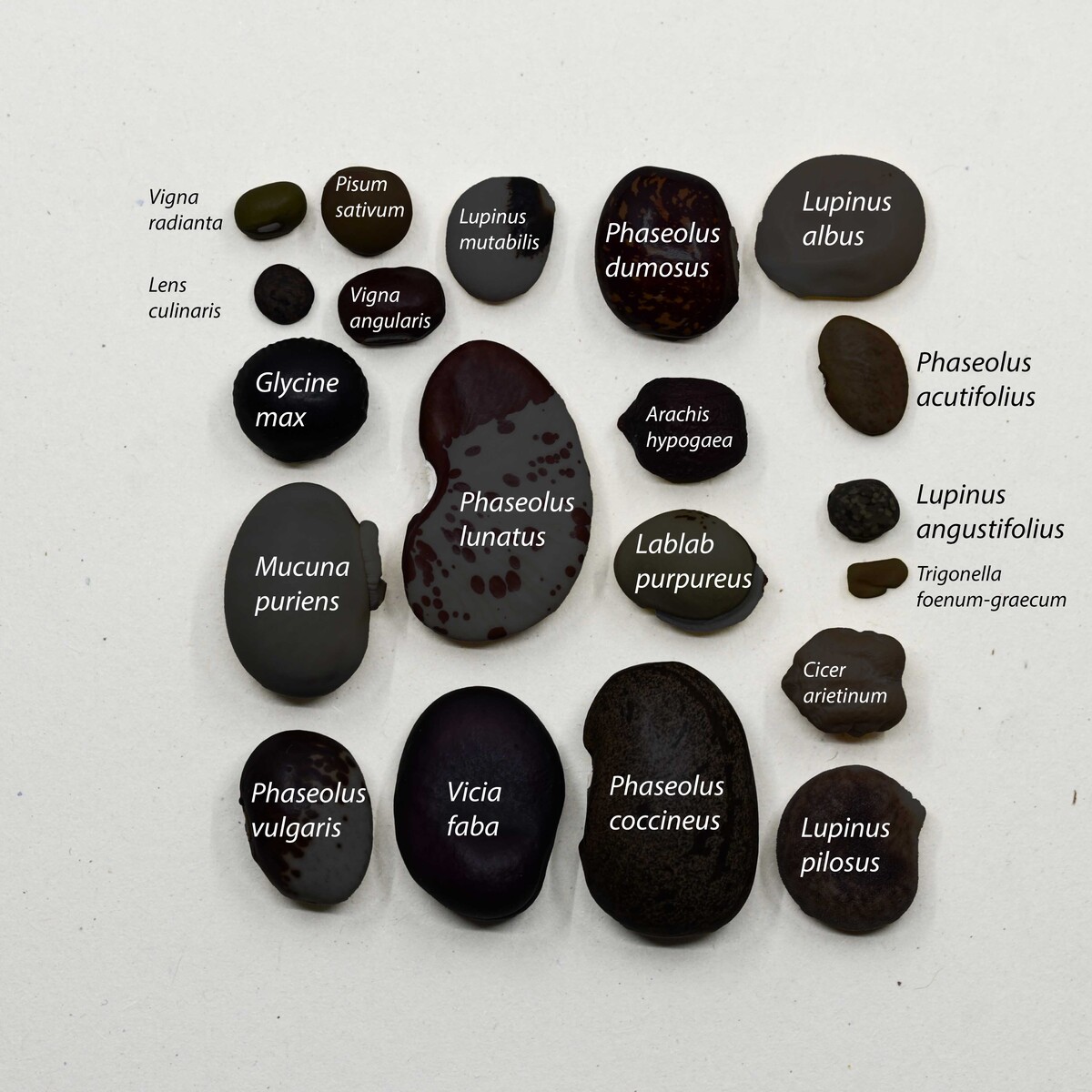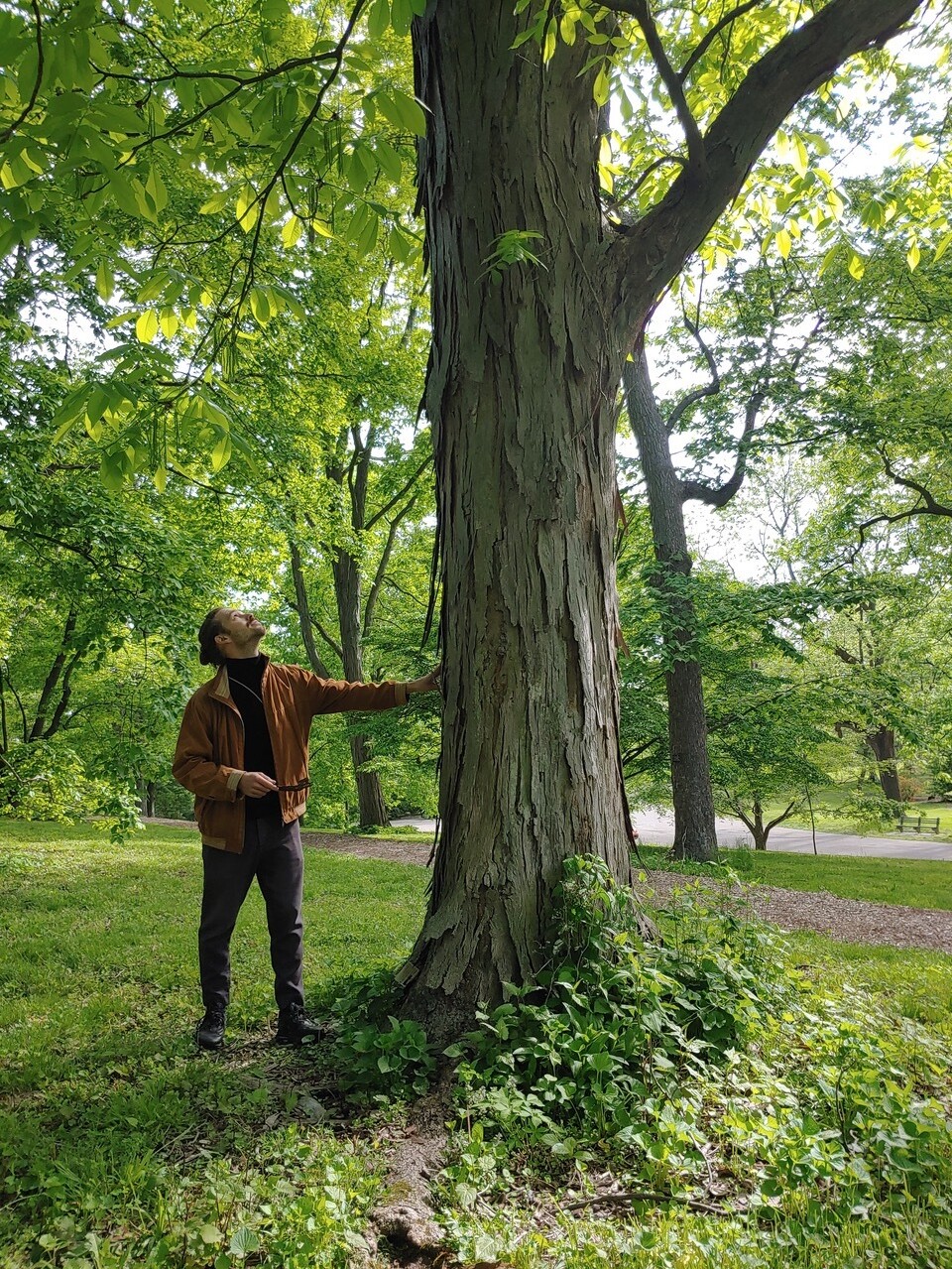Jonas Frei ist Stadtökologe, Landschaftsarchitekt, Autor und leidenschaftlicher Verfechter der Hülsenfrucht. Mit seiner Arbeit schlägt er eine Brücke zwischen urbaner Nachhaltigkeit und kulinarischer Innovation. Frei denkt Food nicht nur als Genuss, sondern auch als Beitrag zu einer nachhaltigen Zukunft. Seit 2018 setzt er Projekte im Bereich Illustration, Film, Fotografie und als Autor in seinem mit Raphael Kleindienst gegründeten Atelier foifacht um. 2020 hat er den deutschen Gartenbuchpreis gewonnen für das Buch «Die Walnuss». Wir sprechen mit ihm über die Rolle der Hülsenfrüchte im Ernährungssystem, die Vorteile für den Boden und ihre immense Vielfalt.
Du hast bereits ein Buch über die Haselnuss und die Walnuss veröffentlicht. Nun beschäftigst du dich unter anderem mit Hülsenfrüchten. Was fasziniert dich daran?
Die schier unendliche Vielfalt. Die Pflanzenfamilie der Hülsenfrüchtler, die Schmetterlingsblütler oder Fabaceae sind mit rund 20'000 Arten eine der artenreichsten. Natürlich sind nicht alle dieser Arten kulinarisch wertvoll, aber doch viele mehr, als uns im Alltag bewusst ist.
Und neben den Wildarten gibt es unzählige Kulturformen und Sorten. Viele davon haben in der heutigen Landwirtschaft nur noch wenig Bedeutung und müssen gezielt erhalten werden. Weltweit werden deshalb in Erhaltungsprojekten traditionelle Bohnensorten gerettet. Dabei werden derzeit allein von den Neuweltbohnen, Phaseolus, über 115'000 Sorten in Genbanken gelagert. Eine beachtliche Anzahl, besonders verglichen mit den wenigen Sorten, die regelmässig in unseren Gerichten landen. Auch bei der zweiten grossen Bohnengattung, Vigna, ist die Anzahl Akzessionen ähnlich gross.
Diese grossen Zahlen sind zwar eindrücklich, viel faszinierender finde ich aber ihre Ästhetik. Der Sortenreichtum der Bohnen ist derart farbenfroh, dass man bei manchen Kultivaren erstmal an Schmuckstücke, nicht an Nahrungsmittel denkt.
Hülsenfrüchte gelten als klimafreundliche Proteinquelle. Welche Rolle könnten sie deiner Meinung nach im Schweizer oder globalen Ernährungssystem der Zukunft spielen, um Nachhaltigkeit zu fördern?
Beim Anbau von Hülsenfrüchten prallen global betrachtet oft gegensätzliche Extreme aufeinander. Letztlich hängt es in vielen Regionen von den landwirtschaftlichen Systemen ab – und nicht nur von den Kulturen selbst – ob die Produktion zur Nachhaltigkeit beiträgt. Etwa 80 % der globalen Sojaernte landen nicht direkt auf unseren Tellern, sondern werden als Futtermittel in der Fleischproduktion verwendet oder gelangen indirekt in Form von Milch- und Eierprodukten in unsere Ernährung. Diese Art der Produktion, oft begleitet von langen Transportwegen, Brandrodung von Primärwäldern und dem Einsatz von Totalherbiziden, gehört zu den schädlichsten Einflüssen auf unsere Ökosysteme. Im Gegensatz dazu bietet der direkte Konsum von Hülsenfrüchten – insbesondere aus regionalem Anbau und als Ersatz für übermässigen Fleischkonsum – eine hervorragende Möglichkeit, negative Emissionen zu senken. Global bräuchten wir deutlich weniger von ersterem und viel mehr von letzterem.
Auf nationaler Ebene denke ich besonders an die Nischenproduktion: Nur noch selten stammen Dörrbohnen aus der Schweiz, auch Linsen oder Ackerbohnen haben ihren Stellenwert in der hiesigen Landwirtschaft verloren und die oft grossen Import-Distanzen stehen der Nachhaltigkeit im Wege. Dabei sind Hülsenfrüchtler grossartig für die Bodengesundheit und helfen mit, chemischen Dünger zu reduzieren.
Schön wäre es auch, wieder häufiger Bohnen in den Hausgärten zu sehen oder auf Balkonen. Auf diesem Weg etwas für die Selbstversorgung zu tun und alte Sorten gleich selbst zu erhalten ist eine wundervolle Erfahrung.

Welche Vorteile siehst du im Anbau von Hülsenfrüchten im Vergleich zu anderen Kulturen, sowohl für die Landwirtschaft als auch für die Böden?
Leguminosen haben gegenüber anderen Kulturen den Vorteil mithilfe von Knöllchenbakterien Luftstickstoff binden zu können. Damit tragen sie zur Bodenverbesserung- und Düngung bei und können den Bedarf an energieaufwändig hergestellten Stickstoffdüngern vermindern. Oft werden Hülsenfrüchtler als Zwischenfrüchte eingesät, um den Boden für folgende Kulturen zu verbessern. Das geschieht dann oft mit Luzerne oder Klee-Mischungen. Spannend ist aus dem gleichen Grund auch der Gemengeanbau von Erbsen oder Ackerbohnen zusammen mit Getreide. Heute gibt es für solche Mischkulturen im maschinellen Anbau aber kaum Direktverwertung ausserhalb der Futtermittelproduktion.
Kombinierter Anbau ist aber schon lange in der indigenen Landwirtschaft Nord- und Mittelamerikas eine weit verbreitete und wichtige Kulturform. Als «drei Schwestern» werden Bohnen, Mais und Kürbis gemeinsam eingesät. Bohnen liefern Stickstoff, der Mais wird zur Kletterhilfe und der Kürbis sorgt für Beschattung des Bodens. Bis heute hat sich diese Kulturform regional erhalten. Und gleichzeitig lieferten sie die Grundlage für eine reichhaltige, ausgewogene Ernährung. Heute sind solche Konzepte aber eher in Gärten und alternativen Anbausystemen zu finden, weil sie sich nicht zur maschinellen Ernte eigenen.
Wie könnte der vermehrte Anbau und Konsum von Hülsenfrüchten dabei helfen, den CO2-Fussabdruck der Landwirtschaft zu reduzieren?
Erstmal sehe ich ein grosses Potential im Ersatz von industriell hergestelltem Fleisch. Ein Grossteil der angebauten (Soja-)Bohnen geht als Silage direkt in die Fleischproduktion. Wo immer Kühe und Rinder nicht auf der Weide stehen, sondern Grossteils durch Zufütterung vom Acker ernährt werden müssen, zieht dies einen ganzer Rattenschwanz ökologischer Probleme mit sich.
In dieser Logik ist jede Sojabohne die als Edamame oder verarbeitet als Tofu direkt in unseren Mägen landet, ein Schritt in die richtige Richtung. Hülsenfrüchte sind sehr proteinreich und können daher im Teller eine ähnliche Funktion übernehmen wie klassische Fleischgerichte. Sei dies in traditionellen Bohnen-Gerichten oder verarbeitet als vegane Fleischalternativen. Und weiter tragen, wie schon erwähnt, Hülsenfrüchte zur Reduktion des Stickstoff-Düngermitteleinsatzes bei, der sonst mit grossem Energieaufwand hergestellt werden müsste.
Es gibt seltene Hülsenfrüchte, die ausserhalb der üblichen Sorten weniger bekannt sind. Auch am Soil to Soul Symposium sprichst du am Talk «Hülsenfrüchte machen Boden gut» zusammen mit Dominik Flammer über wenig bekannte Arten und Sorten. Welche Arten und Sorten findest du besonders vielversprechend, und warum?
Auch hier ist es primär die Vielfalt, die es mir angetan hat. Besonders faszinierend finde ich etwa die Lima-Bohnen, deren Wildformen in den Anden Südamerikas wachsen. Es gibt unzählige Sorten, welche bei uns kaum bekannt sind. Nicht alle lassen sich in unserem Klima kultivieren, aber ihre Vielfalt ist bezaubernd. Oder die Lupinen, deren mehrere Arten nicht nur faszinierende Zierpflanzen sind, sondern auch grossartige Eiweisslieferanten. Grosses Potenzial sehe ich aber auch bei den vergessen gegangen Faba-Bohnen, welche vor der Einfuhr der amerikanischen Gartenbohne die wichtigste Bohnenart Mitteleuropas war. Es ist Zeit, sie auch bei uns kulinarisch wiederzuentdecken!

Die Kartoffel, einst ein Exot, ist heute in unzähligen Gerichten, mit denen wir uns identifizieren, wie «Rösti» und «Härdöpfelstock» nicht mehr wegzudenken. Es gibt kaum ein Schweizer Gericht mit Hülsenfrüchten. Wie erreichen wir es, dass auch die Hülsenfrüchte fester Teil unserer Ernährung werden?
Die Hülsenfrüchtler waren auch in der Schweizer Ernährung einmal viel besser vertreten als sie es heute sind. Schon in der Bronzezeit wurden Linsen in Mitteleuropa angebaut und auch die Ackerbohne zählte zu den ersten landwirtschaftlich genutzten Pflanzen im Alpenraum. Eintöpfe mit verschiedenen Hülsenfrüchten-Samen waren einst weit verbreitet und Dörrbohnen sind noch gar nicht so lange aus der Mode gekommen. Es ist noch kein Jahrhundert her, da waren frische Stangenbohnen für die Selbstversorgung eine Selbstverständlichkeit in jedem Vorgarten. Heute kommen die Linsen als Dal, die Kichererbsen als Hummus und die Bohnen im Chilli mit der internationalen Küche daher. Neben traditionellen Rezepten, die Potential zur Neuinterpretation haben, sehe ich besonders in diesem Wandel der Essgewohnheiten einen wichtigen Wachstumsmarkt für Hülsenfrüchte. Schön wäre es, wenn wir auch diesen Bedarf in Zukunft vermehrt mit regionaler Produktion decken könnten.
Welches ist dein liebstes Gericht mit Hülsenfrüchten in der Hauptrolle?
Von den traditionellen Dörrbohnen auf der Berner Platte über indisches Dal oder Schlangenbohnen aus dem Wok, Hülsenfrüchtler sind für mich aus vielen Gerichten nicht wegzudenken.
Besonders fasziniert mich aber, wie viele Funktionen Hülsenfrüchtler auf dem Teller einnehmen können. Als vegetarische Proteinquelle, wenn wir etwa an Linsen denken. Als Gemüse, wie etwa die Kefen, als Würze wie die Samen des Bockshornklees oder die aus der Sojabohne fermentierte Sojasauce. Als frische Sprossen, wo oft die Luzerne oder die Mungbohne zum Zug kommt. Als kalorienreicher Brotaufstrich, wie die Erdnussbutter oder «Baked Beans» der englischen und amerikanischen Küche. Oder auch der Akazienhonig, der aus dem Nektar der Robinie oder Akazie und damit ebenfalls von einer Leguminose stammt. Und all das ist bloss eine kleinste Auswahl aus der Vielfalt von Nutzungen aus dieser spannenden Pflanzenfamilie.




